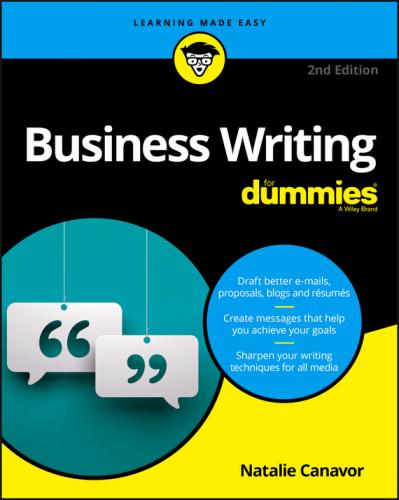Framing the right content at the intersection of goal and audience works equally well for a wide range of business materials (as you find in Chapter 7). You may be surprised to see how the same principles also give you the foundation for long-form materials that often feel like make-or-break opportunities: proposals, reports, and executive summaries. They also equip you to create effective marketing messages and write media releases.
From a 20-second “elevator speech” to introduce yourself to hosting a webinar, the best system is: plan, write, rehearse, then deliver. Chapter 8 shows you how to strategize, write, and prepare for an oral presentation whether formal or less so. Learn how to guide yourself with talking points, an essential technique that enables politicians and CEOs to speak effectively and respond to challenges on their feet. It can work wonders for your own preparation and confidence.
You’ll find that writing for speech purposes relies on the same structure as writing email, letters, and other business documents – Goal + Audience = Content – but the medium suggests tighter technical guidelines than print. You need to aim for simple, clear language based on short, everyday words in natural speaking patterns. Simplicity takes thought!
The basic planning process applies to scripting your own videos and visual-style social media as well. In most cases, ideas must first be shaped in words, even if the core idea is expressed in a single sentence. And even if words end up playing a minor role on screen.
People often assume that when it comes to online content, they can toss all the old writing rules out the virtual window. Big mistake! Digital media with its lightning delivery speed and infinite reach does upend many traditional ideas about communication – top-down thinking, most notably, whereby authoritative figures issue “the word.” Today anyone can market a business, entertain the world, and become a journalist or author. But this democratization makes the need to write well more imperative than ever.
The online world is the great leveler. Never before has there been so much opportunity for individuals, or small enterprises, to make an impact. Equip yourself to use it effectively and the possibilities are boundless. Practice crystallizing your ideas and information into concise, zingy copy. And of course, digital media introduce new demands for interactivity – you want people to respond and share, which demands inventive thinking.
As you read this, I’m sure new technologies are emerging to dazzle and intrigue us. But the newest technology is basically one more delivery system for your messages. You will need clear thinking and good writing to succeed. The techniques presented in this book will not go out of date! But adapt them with imagination.
You may or may not remember, depending on your age, the days when a career job meant a nearly lifetime commitment for both employer and employee. That’s far from the norm now. In fact, the U.S. government estimates that someone entering the workplace now will hold ten different jobs by the age of 40. People in general stay in jobs an average of 4.4 years. So, for most of us, applying for jobs is an ongoing fact of life. This is especially true if you’re part of the Millennial generation, under the age of 35, and share with your cohorts a quick-exit tendency when a job doesn’t satisfy you.
Therefore, you need be an outstanding job applicant. I devote a full chapter (Chapter 10) to writing not just résumés and cover letters, but also successful networking messages. You’ll also find a special section on how to define and explain your own value and equip yourself for interviews.
If you ultimately hope to take a management role, I’ve got you covered in Chapter 14. Learn to establish trust, communicate with staff, share your vision, and write inspiring messages. Great leaders often have a particular skill – storytelling. Using stories as well as anecdotes, examples, and testimonials are within your reach, too. Chapter 9 shows you how to find your own story and shape it to your business needs.
This book is based on American business writing style and practice. North Americans are singularly lucky in that their English has become the international language of business, reflecting the United States’ economic dominance of the past century. But if you run a cross-national business or work for one, it’s a mistake to assume that your audiences in other cultures will read your writing in the way you wish.
Someone who learned English as a second, third, or fourth language may not find your email, letters, and websites easy to understand. Spoken language skills are much easier to acquire than written ones. Further, cultural differences may be much bigger than you think.
